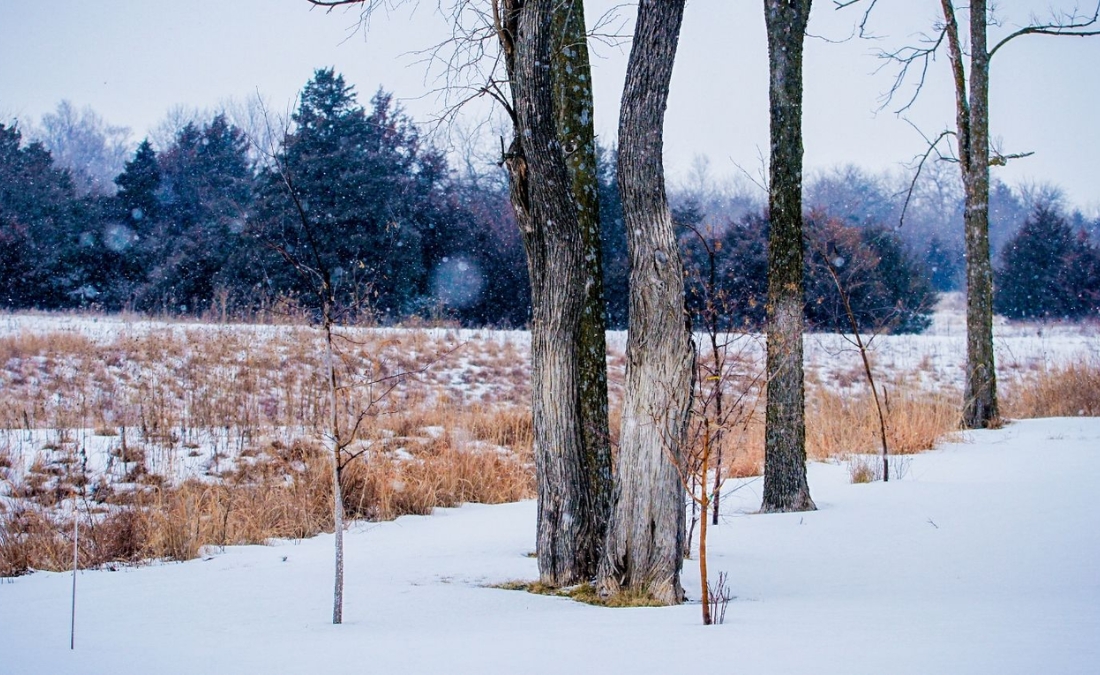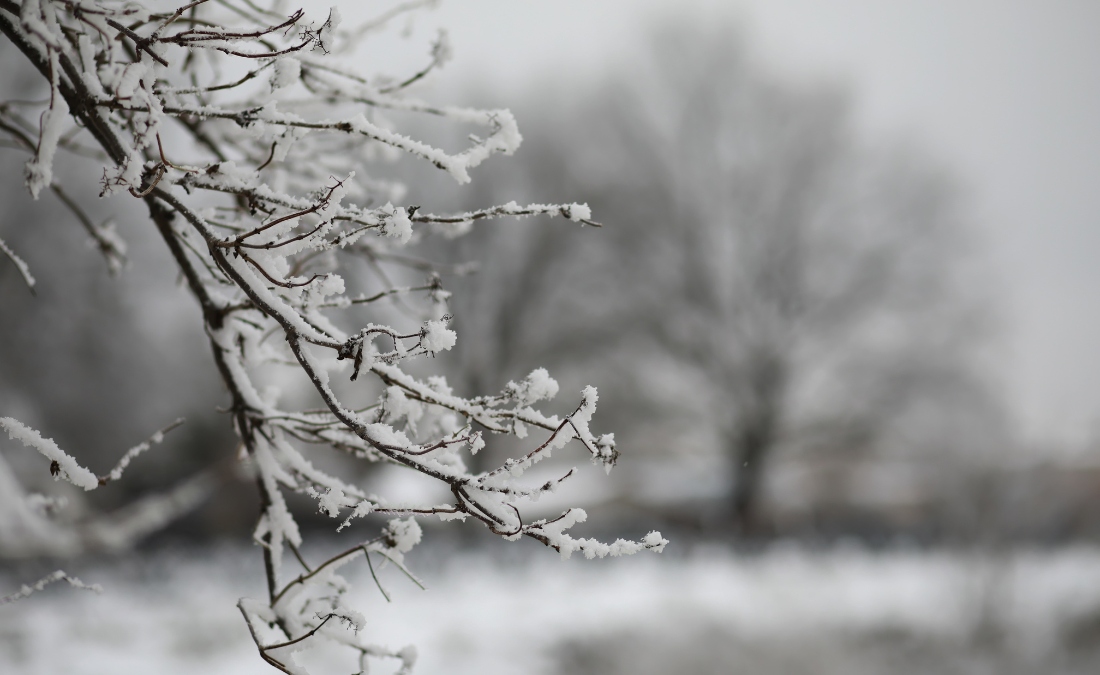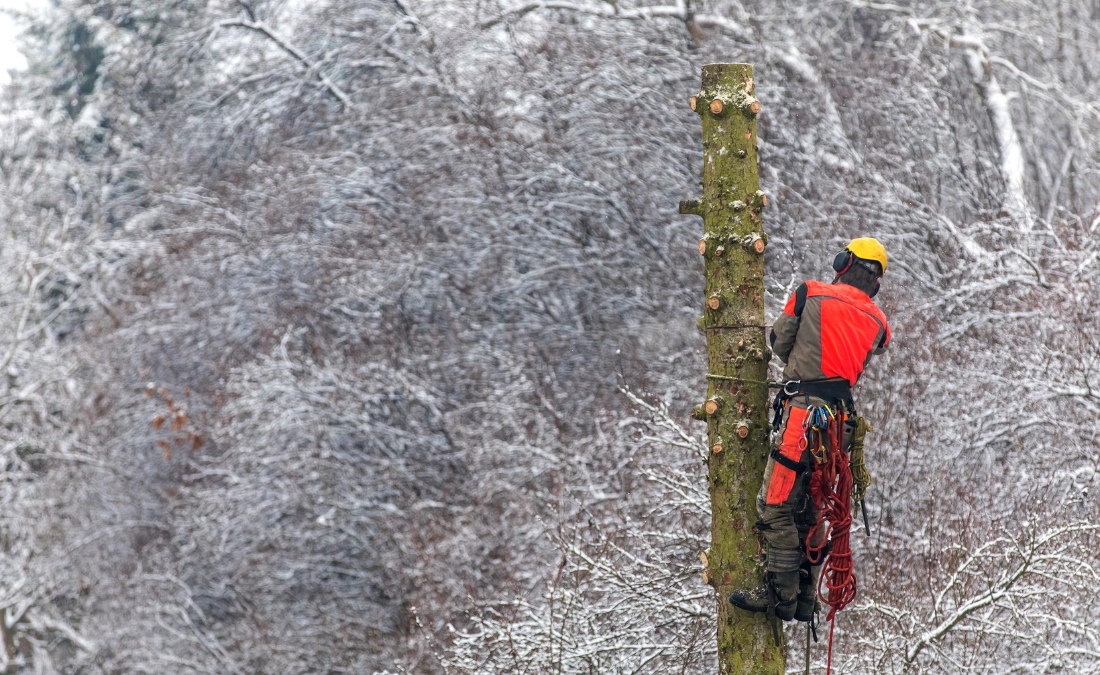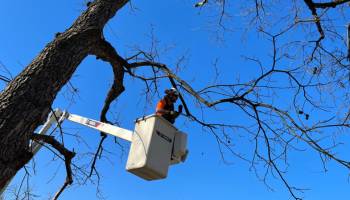Fall Fertilization: The Secret to Stronger, Healthier Trees in Lee’s Summit
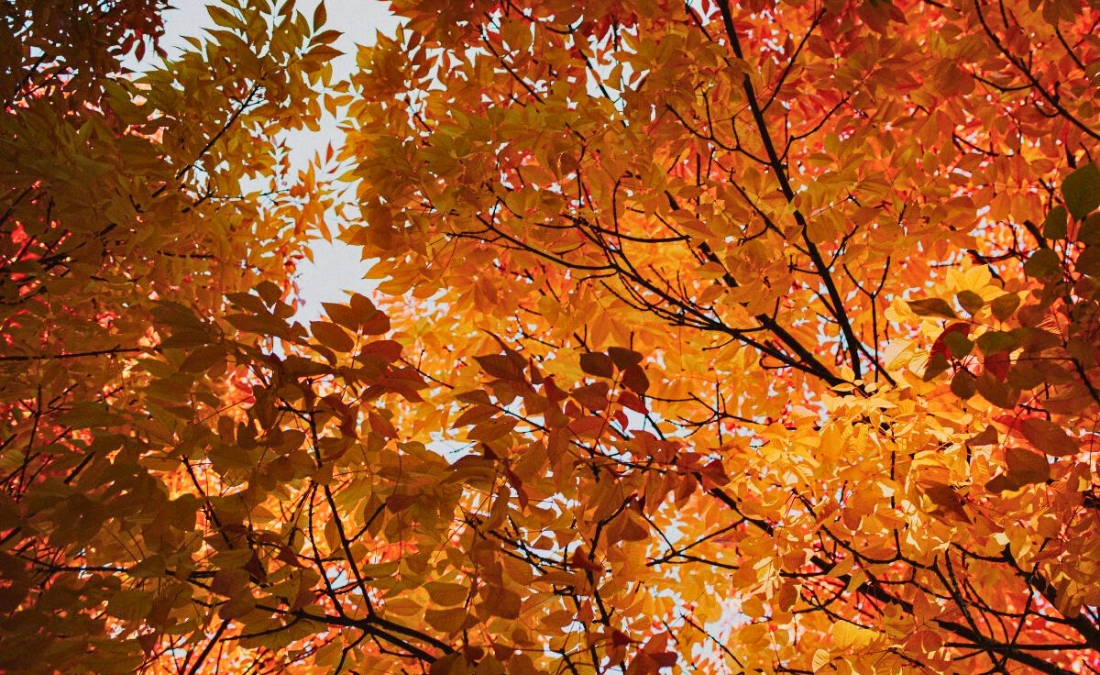
Boost tree health before winter hits. Discover how fall fertilization in Lee’s Summit strengthens roots, fuels spring growth, and protects your landscape.
While you’re raking leaves and winterizing your lawn equipment, your mature trees are preparing for the metabolic marathon that will determine their health, appearance, and storm resistance for the entire next year. In Lee’s Summit, Raytown, and throughout Eastern Kansas City, fall fertilization isn’t just recommended tree care, it’s the difference between trees that continue to add significant value to your property and trees that become expensive removals.
Key Takeaways
- September through November provides the only effective window for nutrient uptake before soil freezes, allowing trees to store energy for explosive spring growth in Lee’s Summit’s challenging climate.
- The clay soil in Jackson and Cass Counties prevents surface fertilizers from reaching tree roots, making professional deep-root injection the only method that actually works for local soil conditions.
- Fall fertilization helps to prevent the iron chlorosis that turns oak and maple leaves yellow every spring, saving you thousands in tree replacement costs while maintaining your property’s curb appeal.
- Mature trees that receive professional fall nutrition develop stronger wood structure and deeper root systems that withstand severe weather.
When Is the Best Time to Fertilize Trees in Lee’s Summit
Eastern Kansas City homeowners have just 10–12 weeks each fall to fertilize effectively. Hitting that window ensures healthier trees – missing it can leave them struggling into spring.
| Month | Optimal Species | Primary Benefits | Application Focus | Soil Conditions |
|---|---|---|---|---|
| September | Oaks, ash, newly planted trees (1+ year) | Maximum iron uptake, early chlorosis prevention | Iron chelation treatments, micronutrient storage | Warm soil temps promote rapid absorption |
| October | Most mature species, maples | Peak nutrient storage window, dormancy prep | Balanced NPK (nitrogen, phosphorus, potassium), root development | Soil temps ideal for deep absorption |
| November | Late-dormancy ash, stressed/recovering trees | Last-chance nutrient absorption before freeze | Recovery nutrition, winter protection compounds | Apply only if soil over 40°F |
Most homeowners don’t realize that tree roots continue actively growing and absorbing nutrients well into winter. While leaves have fallen and branches appear dormant, root systems work overtime storing energy for next spring’s growth flush. Research confirms that trees fertilized after the first hard freeze but before soil freezing show 30-40% more vigorous spring growth compared to unfertilized specimens.
The sweet spot occurs when soil temperatures remain between 40-50°F, typically from mid-October through late November in our region. This timing ensures maximum nutrient absorption while avoiding late-season growth spurts that freeze damage could destroy.
3 Reasons Why Fall Tree Fertilization Works
Understanding how trees actually use the nutrients applied before they go dormant for the year reveals why fall fertilization in the Eastern Kansas City area produces dramatic results that spring applications simply cannot match. Here are the three most important reasons fall fertilization helps trees thrive, giving them strength now and resilience for the coming year.
1. Trees Store Nutrients During Winter Dormancy
When trees enter dormancy, they shift into sophisticated nutrient storage mode, concentrating minerals and carbohydrates in various places:
- Root tissue storage cells that remain active throughout winter
- Trunk cambium layers that protect against freeze damage
- Branch junction points that fuel early spring leaf emergence
- Feeder root zones that maintain soil mineral absorption
Fall-applied fertilizers become the raw materials for these storage compounds, remaining available throughout winter and providing immediate energy when spring growth begins.
2. Fertilizing in Fall Helps Prevent Iron Chlorosis in Spring
Iron chlorosis is a nutritional disorder where trees cannot properly utilize iron despite adequate soil levels, often due to alkaline soil conditions that bind iron into unavailable forms. This condition appears as yellowing leaves with dark green veins and commonly affects oak trees in Lee’s Summit’s alkaline clay
soils. Iron chlorosis not only creates an unsightly appearance that persists throughout the growing season, it also weakens trees significantly.
Fall iron applications work far more effectively than spring treatments because:
- Cooler soil temperatures reduce iron binding to clay particles
- Lower pH levels during fall rains increase iron availability
- Extended absorption time allows proper iron storage in root tissues
- Stored iron becomes available when trees resume active growth in spring, providing season-long chlorosis protection
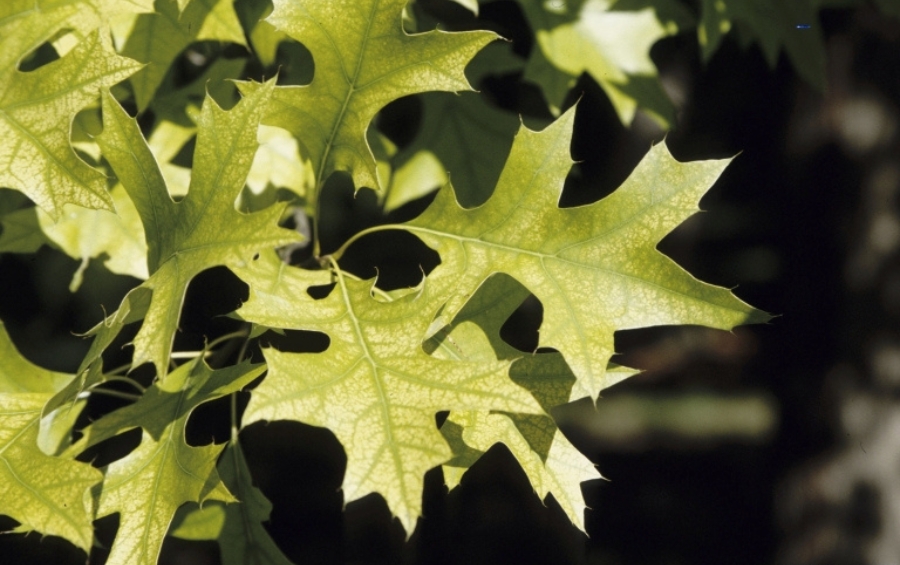
Iron chlorosis symptoms in oak tree leaves. Joseph O’Brien, USDA Forest Service, Bugwood.org
3. Adequate, Proper Nutrition Builds Storm Resistance
Well-fertilized trees develop stronger wood structure and more robust root systems that better withstand storm damage. This proves especially important in Lee’s Summit (and throughout the state of Missouri), where there is always a chance for destructive weather events like tornadoes and severe thunderstorms.
Properly nourished trees flex rather than break during wind events, while their extensive root systems provide better anchorage against soil failure during saturated conditions. The investment in fall fertilization often prevents thousands in storm damage costs.
Why Clay Soils in Jackson and Cass Counties Demand Fall Fertilization
Local clay soil presents unique challenges that make professional deep-root injection fertilization essential rather than optional. The microscopic clay particles create nearly impermeable barriers that prevent traditional surface fertilizers from reaching tree root zones where they’re needed most.
Understanding Clay Soil Challenges
Clay soil throughout Jackson County and Cass County areas, including Raymore, Belton, Grandview, and more, contains high concentrations of clay particles, creating multiple problems for tree nutrition:
- Compaction Barriers: Heavy clay compacts easily, forming hard surface layers that deflect water, air, and nutrients away from root zones.
- Poor Drainage: Tight particle structure holds water on the surface while creating anaerobic conditions that stress tree roots.
- Nutrient Binding: Clay particles chemically bind fertilizer nutrients, making them unavailable even when applied correctly.
- pH Fluctuations: Clay soils swing between alkaline and acidic conditions, affecting nutrient availability throughout the season.
Fall Tree Fertilization Considerations in Lee’s Summit and Raytown Areas
Even with similar soil conditions, different neighborhoods throughout the Greater Kansas City metro area present unique challenges that require customized fertilization approaches. Fortunately, Arbor Masters’ sixty years of local expertise ensures optimal results for your specific property.
Jackson County Service Areas
Jackson County’s established neighborhoods are filled with mature trees that face decades of stress from compacted clay soils, construction, and heavy use. These conditions make professional fertilization especially important for keeping trees healthy and attractive.
Lake Lotawana and Lake Tapawingo Properties:
- Water levels shift throughout the year, which changes how nutrients move through the soil.
- Proximity to water creates unique soil chemistry challenges.
- Extra potassium applications improve drought stress tolerance.
Gregory Boulevard and Mission Hills Neighborhoods:
- Large, 50+ year-old trees require specialized care to maintain strength and appearance.
- Older root systems compete heavily for limited nutrients in compacted urban soils.
- High-value properties require premium appearance standards.
- Years of winter de-icing add salt to the soil, which must be corrected to keep trees healthy.
Lee’s Summit and Blue Springs Areas:
- Many newer subdivisions have disturbed soils left behind from construction.
- Compacted ground and poor soil layering limit root growth and nutrient absorption.
- Lack of natural organic matter makes it harder for trees to establish strong root systems.
- Customized treatments help young trees in these areas adapt and thrive long-term.
Cass County Service Areas
Compared to Jackson County, Cass County often has newer developments and soils that are less compacted – but that doesn’t mean tree care is simple. Local conditions still create challenges that require tailored fertilization to help young and mature trees thrive.
Raymore and Belton Properties:
- Soil types vary between clay and loam, so trees often need a balanced mix of nutrients.
- Many new subdivision trees are still getting established and benefit from treatments that build strong roots early.
- Higher elevation areas face drainage issues that can stress trees.
- Open, windy sites increase tree stress and call for extra support.
Grandview and Peculiar Areas:
- Soil quality can change quickly across properties in these rural–suburban transition zones.
- Fields with a history of farming may have imbalanced soils that need correction.
- Larger properties allow for more comprehensive root zone treatments across many trees at once.
- Preserving native tree stands requires specialized care to protect long-term health.
Why Arbor Masters is Your Trusted Choice for Fall Fertilization in Raytown
When you’re investing in your trees’ long-term health and your property’s value, choosing the right tree care company makes all the difference. Arbor Masters combines decades of local experience with cutting-edge equipment and scientific expertise to deliver results that transform your landscape.
Our Certified Arborists have spent over four decades perfecting fertilization techniques specifically for Eastern Kansas City’s challenging soil conditions. So, we understand exactly how Jackson County and Cass County clay behaves in different seasons and weather conditions, allowing us to time applications for maximum effectiveness.
This deep local knowledge means:
- Precise timing based on soil temperature monitoring and weather forecasting
- Customized fertilizer blends that work in local pH and nutrient conditions
- Injection depths and pressures calibrated for local soil compaction levels
- Species-specific treatments for trees that thrive in our climate zone
Deep-Root Injection Fertilizer Delivers Results
Arbor Masters’ specialized equipment overcomes clay soil limitations through pressurized injection systems that force liquid fertilizer directly into root zones 8-12 inches below the surface. This method bypasses compacted surface layers and delivers nutrients exactly where feeder roots can absorb them immediately.
The unfortunate reality is that surface applications of granular fertilizer simply cannot penetrate our local soil effectively; even expensive “premium” fertilizers remain on the surface where rain washes them away rather than reaching tree roots. For homeowners serious about tree health in our challenging soil conditions, professional deep-root injection isn’t just the better option, it’s the only option that actually works.
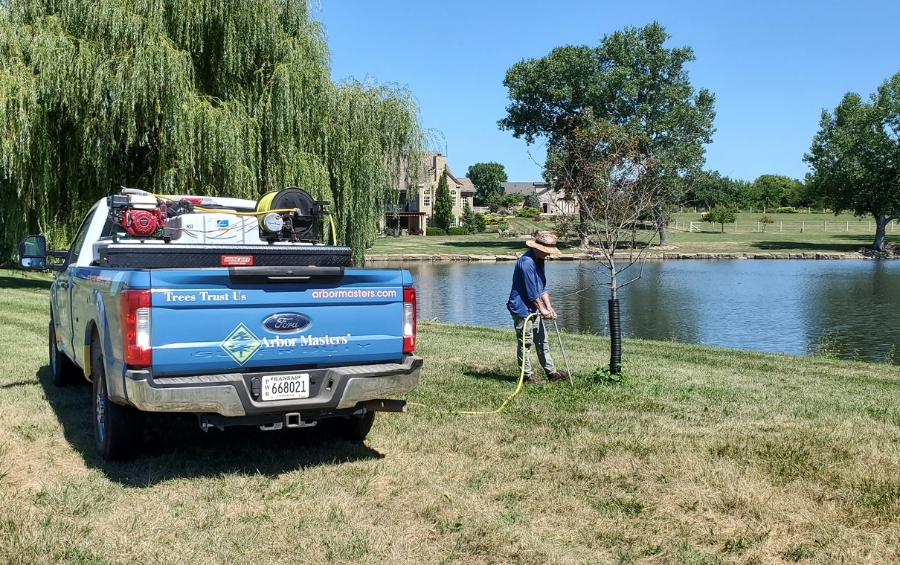
Frequently Asked Questions About Fall Fertilization in Lee’s Summit
How long does it take to see results from fall tree fertilization?
Results from fall fertilization become visible the following spring when trees begin their next growth cycle. You’ll typically notice improved leaf color, larger leaf size, and more vigorous growth within 4-6 weeks of spring emergence. The full benefits, including enhanced storm resistance and overall tree health, develop throughout the entire growing season following treatment.
Will fall fertilization help trees that already show signs of stress or decline?
Fall fertilization can significantly improve stressed trees when combined with proper diagnosis and treatment of underlying problems. However, severely declining trees may require additional interventions like soil modification, root zone expansion, or pest treatment.
Does fall fertilization work for all tree species in the Lee’s Summit area?
Most common shade trees benefit from fall fertilization, but timing and nutrient needs vary by species. Oaks respond best to September applications focused on iron, while maples and ash trees prefer October timing with balanced nutrition. Meanwhile, evergreen trees generally require less frequent fertilization. Our Certified Arborists assess each tree species individually to determine the most effective treatment approach.
Can fall fertilization be done if we have an early freeze or snow?
Early freezes don’t prevent fall fertilization as long as soil temperatures remain above 40°F. Our equipment can work through light snow conditions, and injection methods actually work better in firm soil. We monitor soil conditions closely and adjust timing recommendations based on actual ground conditions rather than air temperature alone.
What happens if I miss the fall fertilization window this year?
Missing fall fertilization means trees lose their primary opportunity for nutrient storage before winter. Spring fertilization can provide some benefits but won’t achieve the same results as fall applications. Trees may show reduced growth, increased stress susceptibility, and higher risk of chlorosis the following year.
Do young trees need different fertilization than mature specimens?
Young trees (under 10 years) typically need lighter, more frequent fertilization focused on establishment and root development. Mature trees require deeper, more comprehensive treatments that address long-term health and stress resistance.
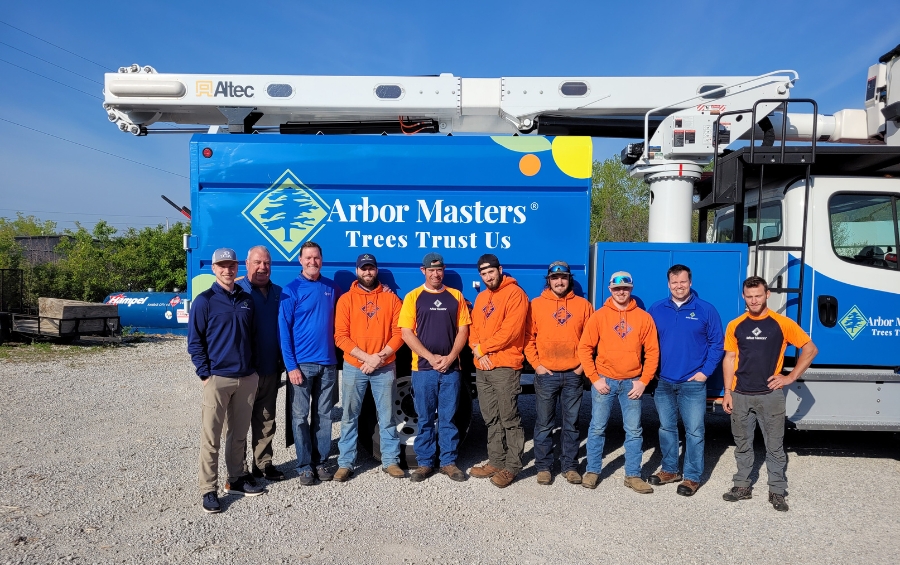
Schedule Your Fall Tree Fertilization with Arbor Masters Today
The narrow window for effective fall fertilization is closing fast, and your trees are counting on the nutrition they need to survive winter and thrive next spring. Every day you wait is a day your trees lose valuable nutrient storage time that can’t be recovered.
Don’t gamble with your landscape investment or watch your property values decline from unhealthy trees. Call 913-441-8888 or request a quote online to get started today.
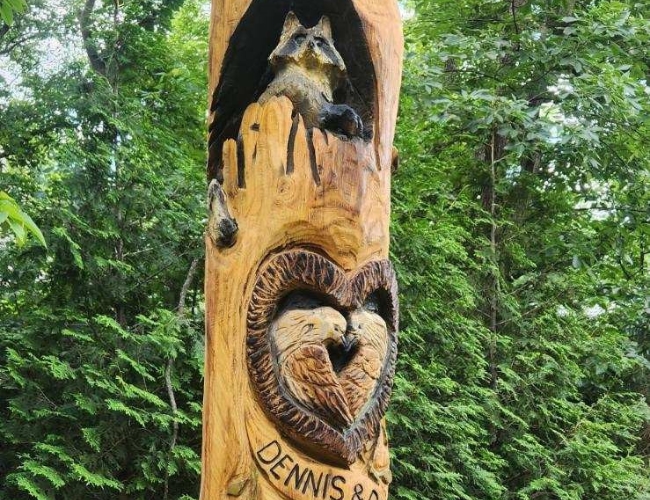
Get the latest local news, tree care tips, special offers, and company updates directly to your inbox! It's easy to subscribe and there's no spam - we promise.
"*" indicates required fields


